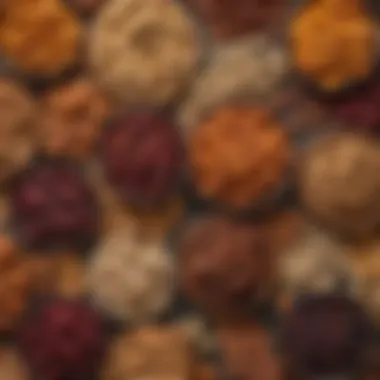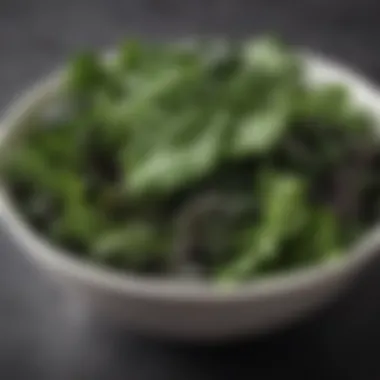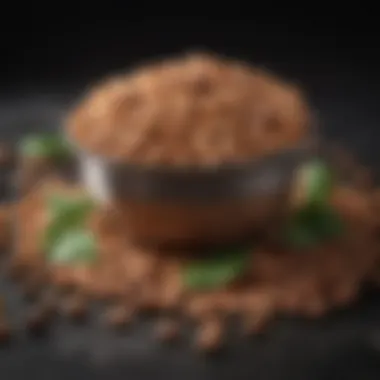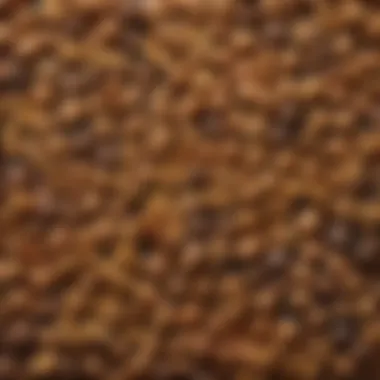Discover Iron-Rich Snacks for Better Health


Intro
Iron is an essential mineral that plays a critical role in our overall health. Without sufficient iron, the body struggles to function properly. This deficiency can lead to fatigue, weakness, and other health issues. Understanding the significance of this mineral can foster informed dietary choices. By incorporating iron-rich snacks into our meals, we can improve our iron intake while enjoying tasty options.
In today’s exploration, we will discuss the importance of iron, highlight various snacks that are abundant in this nutrient, and offer practical tips for better integration into your diet. Moreover, the article will illuminate the distinction between heme and non-heme iron sources and suggest effective methods for enhancing iron absorption. This comprehensive guide aims to empower food lovers of all ages to make choices that promote better health.
Recipe Overview
Iron-Rich Snack Ideas
In this section, we will present several snack ideas that are packed with iron. Each suggestion is not only nutritious but also easy to prepare. These snacks serve as convenient options for those seeking to enrich their diets with this vital mineral.
Ingredients List
Main Ingredients
- Chickpeas – A great source of non-heme iron.
- Spinach – Leafy greens rich in iron and antioxidants.
- Pumpkin seeds – Highly concentrated in iron and other nutrients.
- Dark chocolate – Not just a treat; it offers iron too.
- Lentils – Another excellent non-heme iron source.
Optional Ingredients
- Dried fruits – Such as apricots or raisins for extra flavor and nutrients.
- Nuts – Almonds and cashews can enhance both taste and nutritional value.
By thoughtfully selecting and combining these ingredients, snacks can be both delightful to eat and beneficial for your health.
Prologue to Iron and Its Importance
Iron is more than just a mineral; it is a fundamental component of numerous biological processes and has pivotal roles in maintaining overall health. In the context of this article, we will explore how iron affects our bodies and the significance of incorporating iron-rich snacks into our daily diets. Understanding iron is crucial for everyone. It helps not only to prevent deficiency but also ensures that one’s energy levels and cognitive functions remain optimal.
Understanding Iron
Iron is a trace mineral present in the body. It exists in two forms: heme and non-heme. Heme iron is derived from animal sources, such as meat and fish, whereas non-heme iron is largely found in plant-based foods. Interestingly, although both types are important, the body absorbs heme iron more effectively.
Iron forms part of hemoglobin, the protein in red blood cells that transports oxygen. Thus, a sufficient intake of iron is crucial for sustaining energy levels and preventing fatigue. Without adequate iron, the body cannot produce enough healthy red blood cells. This underlines why people need to understand their iron intake and choose foods that bolster their levels.
Role of Iron in the Body
Iron carries out several essential functions. It is integral to oxygen transport and plays a large part in energy metabolism, which is why low iron levels can lead to decreased stamina and resilience. An adequate supply of iron directly influences mental well-being as well. Insufficient iron can contribute to cognitive decline, further complicating the need for proper dietary intake.
In summary, iron is necessary for:
- Oxygen transport: Without iron, hemoglobin cannot effectively bind and release oxygen to cells.
- Energy production: Iron helps in converting food into energy.
- Immune function: Adequate levels support a robust immune system.
In essence, the importance of iron going beyond simple mineral intake is critical in fostering a balanced and healthy lifestyle.
Types of Iron: Heme vs. Non-Heme
Understanding the types of iron is crucial when discussing the importance of this mineral in our diet. Iron exists in two primary forms: heme and non-heme. Both types play essential roles in the body, but they differ in their sources and how well the body absorbs them. Being aware of these differences can help individuals choose better dietary options to meet their iron needs.
Heme Iron Sources
Heme iron is typically found in animal products. This form of iron is absorbed more efficiently by the body compared to non-heme iron. It is primarily sourced from:


- Red meats: Beef and lamb are notable high sources. They provide substantial amounts of iron in a form the body uses effectively.
- Poultry: Chicken and turkey, particularly dark meat, contain heme iron.
- Seafood: Fish and shellfish, such as oysters and sardines, also provide heme iron.
Food that holds heme iron usually helps maintain healthy iron levels. It is essential for people who are at risk of iron deficiency or developing anemia. Consuming heme iron alongside foods rich in vitamin C can further enhance absorption, making it a practical choice for those concerned about their iron intake.
Non-Heme Iron Sources
Non-heme iron, on the other hand, is found in plant food sources as well as in fortified products. While it is not absorbed as well as heme iron, it remains an important part of a balanced diet. Common sources of non-heme iron include:
- Legumes: Lentils, chickpeas, and black beans are excellent options. They are not only rich in iron but also provide protein and fiber.
- Nuts and Seeds: Pumpkin seeds, cashews, and almonds offer non-heme iron, making them ideal snacks.
- Whole Grains: Foods like quinoa and brown rice are beneficial sources, alongside more processed snacks like oatmeal bars.
- Dark Leafy Greens: Spinach and kale contain non-heme iron, but they may also have substances that inhibit absorption, which requires careful pairing.
Integrating both heme and non-heme iron sources into your diet is beneficial. While heme iron provides easy absorption, non-heme iron can be adequate when consumed in sufficient quantities, especially for those following a plant-based or vegetarian diet. To enhance non-heme iron absorption, combining these foods with vitamin C-rich items can be effective. Understanding these differences allows for a better-informed dietary decision.
Snacks Rich in Iron
The inclusion of iron-rich snacks in one's daily diet is essential for maintaining optimal health. Iron plays a critical role in transporting oxygen throughout the body, and adequate levels contribute to overall energy, focus, and well-being. By selecting nutrient-dense snacks that are high in iron, individuals can better meet their dietary requirements while enjoying convenient and delicious options. This segment delves into various snack categories, each providing significant iron content, and presents their unique benefits, making them suitable for those keen on enriching their diets.
Nuts and Seeds
Pumpkin Seeds
Pumpkin seeds are known for their substantial iron content. A remarkable feature of pumpkin seeds is that they contain heme iron, which is more readily absorbed by the body than non-heme iron. This makes them a particularly beneficial choice for individuals who are looking to enhance their iron intake efficiently. The crunchy texture and nutty flavor not only make them a popular snack but also easy to incorporate into salads or mixed nuts. One drawback is that they should be eaten in moderation due to their calorie density.
Cashews
Cashews are another excellent source of iron. What sets cashews apart is their creamy texture and rich taste, making them a favorable snack for many. They contain a good balance of healthy fats and protein along with iron, which supports overall nutrition. Their versatility allows them to be consumed alone or mixed into various dishes. However, they can be higher in fat, so portion control is essential to maintain a balanced intake.
Almonds
Almonds are widely recognized for their health benefits, including their contribution to iron intake. They are particularly noted for their crunchy texture and slightly sweet flavor, making them a popular choice for snacking. Almonds not only provide iron but also contain vitamin E, which is beneficial for skin health. An important consideration is to choose unsalted varieties to avoid excessive sodium intake, as this may counteract some of their health benefits.
Legumes
Lentil Snacks
Lentil snacks, gaining popularity in the health food market, are an excellent way to obtain dietary iron. They are high in protein and fiber, offering a satiating option that satisfies hunger. The unique property of lentils is their ability to be transformed into various snack forms, such as chips or bars, while still retaining their nutritional value. However, some individuals may find them harder to digest, which is worth noting when incorporating them into a diet.
Chickpea Roasters
Chickpea roasters are another convenient and iron-rich option. These roasted legumes provide a crunchy snack alternative packed with iron and other nutrients. Their appeal lies in their versatility, as they can be seasoned with various spices to enhance flavors. One potential disadvantage is that they are relatively high in carbohydrates, so consuming them alongside other protein-rich foods can help balance overall nutrition.
Edamame
Edamame, or young soybeans, is known for its bounty of nutrients including iron. Edamame is often served steamed, making it a quick snack option. Its unique feature is its high protein content relative to other snacks, providing an energy boost as well. However, individuals with soy allergies should exercise caution, making it necessary to consider other snacks that meet iron needs without allergens.
Whole Grains
Oatmeal Bars
Oatmeal bars can be a very satisfying way to increase iron intake. They are typically made from oats, which naturally contain a fair amount of iron. These bars are convenient, portable, and can often be found in various flavors, appealing to diverse tastes. The only concern is the potential for added sugars in commercial bars, so reading labels is crucial to ensure a healthy choice.
Quinoa Crackers
Made from quinoa, these crackers serve as a unique source of iron. Quinoa is a complete protein, providing all nine essential amino acids while also being rich in iron. The flavor profiles can vary based on seasonings, diversifying snack options. The downside is that they might be less filling compared to denser snacks, possibly leading to increased consumption.


Brown Rice Cakes
Brown rice cakes are light and versatile snacks that also contribute iron. Their key characteristic is their crispy texture, often used as a base for various toppings. They are low in calories, making them an appealing choice for those watching their intake. However, their lower iron content compared to other options means they should be paired with additional iron sources for optimal benefits.
Dark Chocolate
Dark chocolate, especially varieties that are high in cocoa content, can be an indulgent iron-rich snack. It contains flavonoids that provide health benefits beyond just iron supplementation. The benefit of dark chocolate is its satisfying sweetness while also delivering nutrients. On the downside, moderation is key due to its calorie and sugar content. Integrating dark chocolate into a balanced diet can help satisfy sweet cravings while boosting iron levels.
Benefits of Low-Prep Iron-Rich Snacks
Incorporating iron-rich snacks into your diet has numerous benefits, especially when these snacks require minimal preparation. The convenience of low-prep snacks allows individuals to maintain their iron intake without the burden of lengthy cooking processes. These snacks facilitate healthier eating habits, serving as efficient fuel for everyday activities while ensuring that nutritional needs are met effectively.
Convenience and Accessibility
Low-prep iron-rich snacks are particularly valuable for busy lifestyles. Many people face time constraints that make preparing elaborate meals challenging. Snacks like pumpkin seeds or almond butter can be easily integrated into a hectic schedule. With such options available, one does not need to sacrifice nutrition due to a lack of time. These snacks are often portable, making them suitable for work, school, or travel. When craving a quick bite, choosing a snack high in iron helps ensure that the body receives the necessary minerals to function efficiently.
Supporting Energy Levels
Low-prep snacks rich in iron can have a significant impact on energy levels. Iron plays a critical role in the production of hemoglobin, the protein in red blood cells that carries oxygen throughout the body. When iron levels are adequate, the body efficiently transports oxygen, resulting in better overall energy and stamina. Convenient sources like dark chocolate or roasted legumes can provide a quick energy boost during the day. Utilizing these snacks allows individuals to avoid the typical energy crashes associated with processed alternatives.
Enhancing Mood and Cognitive Function
Iron is directly linked to mood and cognitive performance. A deficiency can lead to fatigue, irritability, and reduced mental clarity. Low-prep iron-rich snacks not only help mitigate these effects but also contribute to prolonged focus and better mood stability. Consuming snacks high in iron can support neurotransmitter function, thus improving concentration. For example, a handful of cashews or a protein-rich energy ball can serve as effective snacks that nourish both the mind and body, paving the way for enhanced productivity.
Incorporating low-prep iron-rich snacks into one's routine offers both nutritional benefits and practical advantages, making them an essential component of a balanced diet.
This approach to snacking aligns with the goal of maintaining a high-iron diet while accommodating modern demands, thus supporting overall well-being.
Factors Affecting Iron Absorption
Understanding how to absorb iron effectively is crucial. Iron absorption can vary based on several elements. These elements can significantly influence the benefits derived from iron-rich snacks. Recognizing these factors may help you maximize iron's positive effects on health.
Vitamin and Iron
Vitamin C plays a vital role in enhancing the absorption of non-heme iron, the type found in plant-based foods. When consuming foods rich in iron, pairing them with vitamin C sources is beneficial. Citrus fruits like oranges, strawberries, and kiwis, as well as bell peppers and broccoli, can boost iron absorption when incorporated into meals. This is especially important for individuals relying on non-heme sources for their iron intake. A simple strategy such as adding a fresh salad with lemon juice to lentil snacks can bolster iron absorption.
Impact of Tannins and Phytates
Tannins and phytates are naturally occurring compounds that can inhibit iron absorption. Tannins are often found in tea, coffee, and some red wines. Phytates are common in whole grains and legumes. When consumed in large amounts, these compounds bind to iron and make it less available for absorption in the body. To minimize these effects, consider the timing of your meals. For example, drinking tea or coffee several hours after meals may help enhance iron intake from snacks.
Combining Foods for Optimal Absorption
Combining specific foods can further optimize iron absorption. Consuming heme iron sources, such as lean meats or fish, alongside non-heme sources enhances overall iron uptake. For instance, a meal combining chickpeas and grilled chicken provides a synergistic effect. Including healthy fats can also aid iron absorption. Foods like avocados or olive oil can facilitate the uptake of nutrients, particularly in vegetarian meals. This strategic combination of foods can help you meet your daily iron needs efficiently.
Research indicates that careful planning of meals can significantly influence dietary iron status, especially for individuals at higher risk of deficiency.
By understanding the factors affecting iron absorption and applying this knowledge, you can create meals and snacks that not only fulfill iron requirements but also improve overall health.
Incorporating Iron-Rich Snacks Into Your Diet
Incorporating iron-rich snacks into your diet is critical. Iron is not only necessary for oxygen transport but also plays a key role in various metabolic processes. Consistent consumption of snacks that are high in iron can help ensure you meet your daily requirements. Furthermore, these snacks come in diverse forms that can easily fit into an on-the-go lifestyle, making it convenient to boost your iron intake without sacrificing taste or nutrition.


The benefits of having iron-rich snacks extend beyond just meeting nutritional needs. They help in maintaining energy levels, supporting immune functions, and improving cognitive performance. It is important to recognize the ease with which individuals can add these snacks to their daily routines. However, care should be taken to focus on both dietary sources and methods of preparation to maximize the benefits of iron absorption.
Snacking Habits to Cultivate
Developing healthy snacking habits is beneficial for maintaining adequate iron levels. One way to integrate iron-rich options is by keeping a supply of snacks at hand. For instance, having nuts like cashews or almonds readily available can encourage consumption. Here are some habits you may consider:
- Choose whole foods: Opt for snacks made from whole ingredients such as legumes or seeds.
- Pre-portion snacks: Divide larger bags of snacks into single servings to prevent overeating and to make it easier to grab on the go.
- Stay mindful of food combinations: Pair iron-rich snacks with sources of vitamin C. This combination enhances absorption, so consider some orange slices or bell pepper strips alongside your nuts.
Meal Prep Ideas for Iron-Rich Snacks
Meal preparation can streamline the process of consuming iron-rich snacks. Planning in advance ensures you have a variety of options available throughout the week. Here are a few meal prep ideas to get you started:
- Homemade Trail Mix: Combine unsalted nuts, seeds, and a few dark chocolate pieces. This provides a delicious balance of flavors and nutrients.
- Chickpea Roasters: Bake chickpeas with your favorite spices for a crunchy snack that is easy to make in large batches.
- Energy Balls: Create energy bites using oats, nut butter, and iron-rich ingredients such as hemp seeds. These can be stored in the fridge and make for a quick pick-me-up.
- Veggie and Hummus Packs: Portion out baby carrots or cucumbers paired with hummus, which is rich in non-heme iron.
In summary, incorporating iron-rich snacks involves adopting habits that promote healthier choices while preparing meals that are convenient and appealing. With careful planning and mindful pairing of food types, you can effectively enhance your iron intake. This not only contributes to overall health but ensures you enjoy your snacks without compromise.
The End: Prioritizing Iron Intake
Iron is more than a mineral. It is a vital component that influences numerous biological functions in the human body. Prioritizing iron intake is essential for maintaining overall health and well-being. This article highlights how iron supports oxygen transport, energy metabolism, and cognitive function. The necessity for including nutrient-rich snacks in one’s daily regimen cannot be overstated.
A proactive approach to dietary choices can lead to enhanced iron levels. Understanding the difference between heme and non-heme iron helps individuals make informed choices that can optimize their iron intake. Regular consumption of iron-rich snacks is also a simple strategy for enriching one’s diet without the complexities of meal planning. By selecting snacks like nuts, seeds, and legumes, one can effortlessly integrate iron-rich foods into daily life, thereby reducing the risk of deficiency.
Additionally, the benefits of low-prep iron-rich snacks extend beyond just meeting nutritional needs. Such snacks offer convenience and variety, making it easier for individuals to stay energized throughout the day. Over time, this can bolster one’s mood and cognitive capabilities, forming a significant part of a balanced lifestyle.
Inclusion of vitamin C and being aware of inhibitors, such as tannins, is vital for those looking to enhance iron absorption. Careful attention to these factors can substantially improve the body’s ability to utilize the iron consumed through diet. Thus, it is clear that prioritizing iron intake is not merely an academic interest, but a practical necessity for better health outcomes.
Recap of Key Points
- Iron’s Role: Iron is crucial for oxygen transport and energy.
- Sources: Include both heme (animal-based) and non-heme (plant-based) iron.
- Iron-Rich Snacks: Incorporate snacks like nuts, seeds, and legumes.
- Absorption Factors: Pairing with vitamin C aids absorption; avoid inhibitors like tannins.
- Health Benefits: Regular snacks support energy, mood, and cognitive function.
The Role of Iron in a Balanced Diet
Iron serves multiple roles in ensuring the body operates efficiently. It is a key player in producing hemoglobin, which transports oxygen in the blood. Without adequate iron, individuals may suffer from fatigue, reduced immunity, and cognitive impairments. The importance of a balanced diet rich in iron cannot be understated, especially for populations at risk like pregnant women, vegetarians, and individuals with certain medical conditions.
To achieve a well-rounded diet, combining heme and non-heme sources is recommended, as each type offers distinct advantages. Heme iron is absorbed more easily by the body, while non-heme iron is abundant in plant-based foods. Both types contribute significantly to meeting iron needs and support various bodily functions effectively. Encouraging a mix of these sources enhances dietary flexibility and sustainability.
By recognizing iron's critical functions and ensuring that dietary practices prioritize sufficient intake, one can foster a healthier lifestyle. Ultimately, integrating iron-rich snacks into your daily routine is a wise strategy for achieving your dietary goals.
References and Further Reading
In the exploration of iron and its pivotal role in our diet, it's crucial to provide evidence and further insights through credible references and additional readings. By including this segment, we give readers a comprehensive understanding of the underlying science and practical applications associated with iron intake. Quality sources reinforce the information discussed throughout the article while empowering readers with the tools to deepen their knowledge on the topic.
Importance of References
References serve as a backbone for any informative piece. They validate the content presented and foster trust between the writer and the readers. For example, peer-reviewed studies from journals can clarify how iron deficiency can lead to anemia, impacting overall health. Additionally, expert opinions, guidelines from health organizations, and nutritional databases can offer detailed contexts for specific recommendations on iron-rich snacking.
Including a variety of sources allows the reader to explore different aspects of iron's importance without being limited to a single viewpoint. This enhances critical thinking and encourages further research, which is essential for a well-rounded understanding.
Further Reading Suggestions
Readers interested in delving deeper into the significance of iron in nutrition and health can explore the following resources:
- Wikipedia - General overview of Iron
- Encyclopedia Britannica - Comprehensive articles on iron’s functions in the body
- Reddit Discussions - Community insights and personal experiences regarding dietary iron
- Facebook Groups - Networking with other food enthusiasts who share their thoughts on iron-rich diets
Benefits of Further Reading
Investing time in further reading allows individuals to:
- Enhance personal knowledge on nutrition.
- Discover new iron-rich snack recipes.
- Understand controversial topics within nutrition related to iron.
- Stay updated with the latest research in dietary practices.







